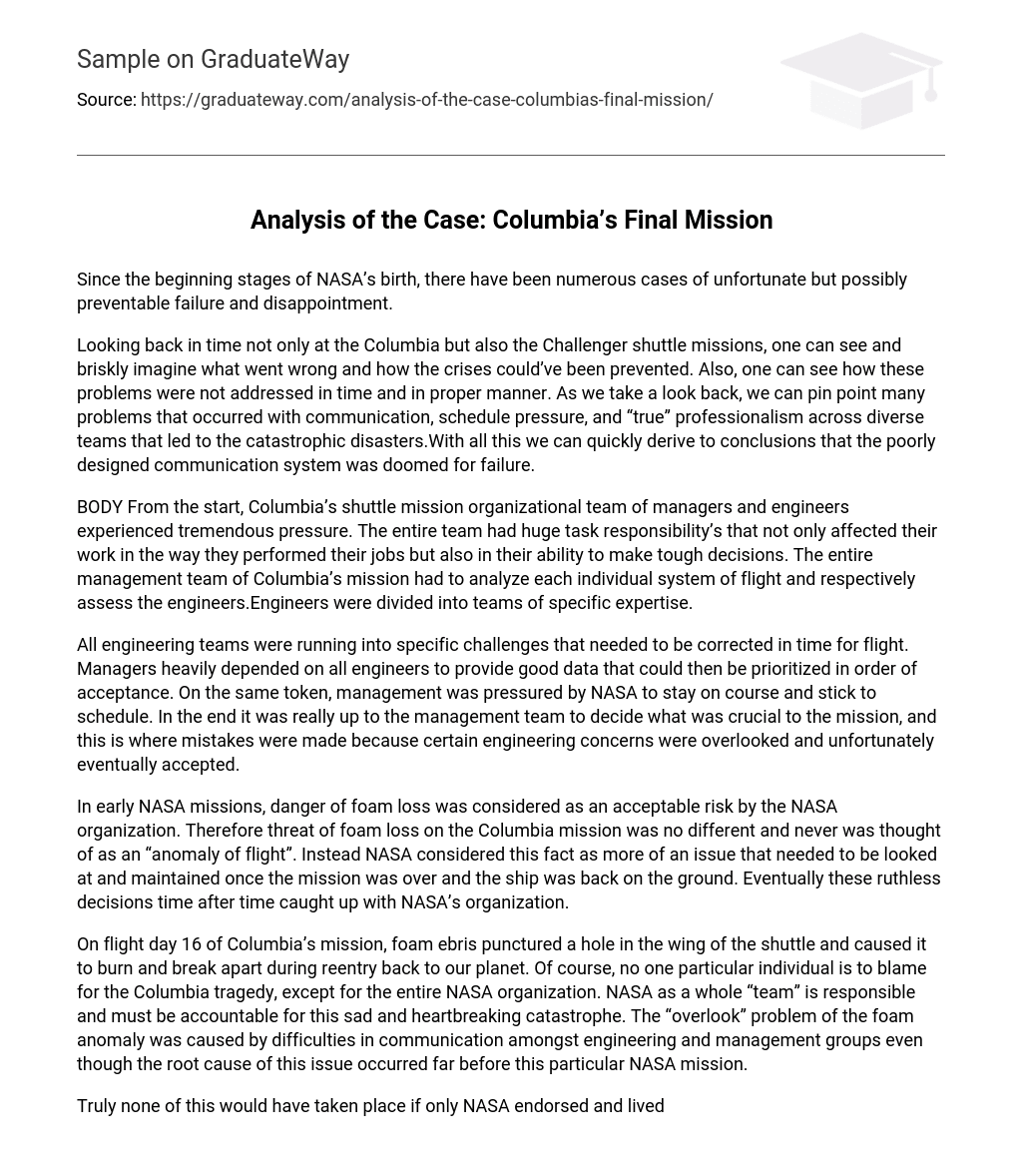Since the beginning stages of NASA’s birth, there have been numerous cases of unfortunate but possibly preventable failure and disappointment.
Looking back in time not only at the Columbia but also the Challenger shuttle missions, one can see and briskly imagine what went wrong and how the crises could’ve been prevented. Also, one can see how these problems were not addressed in time and in proper manner. As we take a look back, we can pin point many problems that occurred with communication, schedule pressure, and “true” professionalism across diverse teams that led to the catastrophic disasters.With all this we can quickly derive to conclusions that the poorly designed communication system was doomed for failure.
BODY From the start, Columbia’s shuttle mission organizational team of managers and engineers experienced tremendous pressure. The entire team had huge task responsibility’s that not only affected their work in the way they performed their jobs but also in their ability to make tough decisions. The entire management team of Columbia’s mission had to analyze each individual system of flight and respectively assess the engineers.Engineers were divided into teams of specific expertise.
All engineering teams were running into specific challenges that needed to be corrected in time for flight. Managers heavily depended on all engineers to provide good data that could then be prioritized in order of acceptance. On the same token, management was pressured by NASA to stay on course and stick to schedule. In the end it was really up to the management team to decide what was crucial to the mission, and this is where mistakes were made because certain engineering concerns were overlooked and unfortunately eventually accepted.
In early NASA missions, danger of foam loss was considered as an acceptable risk by the NASA organization. Therefore threat of foam loss on the Columbia mission was no different and never was thought of as an “anomaly of flight”. Instead NASA considered this fact as more of an issue that needed to be looked at and maintained once the mission was over and the ship was back on the ground. Eventually these ruthless decisions time after time caught up with NASA’s organization.
On flight day 16 of Columbia’s mission, foam ebris punctured a hole in the wing of the shuttle and caused it to burn and break apart during reentry back to our planet. Of course, no one particular individual is to blame for the Columbia tragedy, except for the entire NASA organization. NASA as a whole “team” is responsible and must be accountable for this sad and heartbreaking catastrophe. The “overlook” problem of the foam anomaly was caused by difficulties in communication amongst engineering and management groups even though the root cause of this issue occurred far before this particular NASA mission.
Truly none of this would have taken place if only NASA endorsed and lived by an open culture environment. CONCLUSION Overall, the most crucial aspect we all can learn from this tragedy is that clear communication is gateway to great teamwork and data proven, decisive choices. In theory, if clear communication existed between management and employees at NASA prior to the catastrophe, problems could have been zeroed out. An open communication environment could have allowed all members of the organization to be heard, analyzed and addressed by everyone on the organizational chart from top to bottom.
In essence, a solid organization must have a feasible process that addresses known threats with clear and decisive communication. Also in addition to an adequate communication environment, safety should remain the number one priority. All problems must be fixed prior to shuttle launch and no individual risk should be accepted. Benefits of such process can be viewed and attained by all individuals involved in a project of great magnitude, and maybe if such process existed in NASA prior to the Columbia launch, perhaps we wouldn’t be discussing these issues today.





